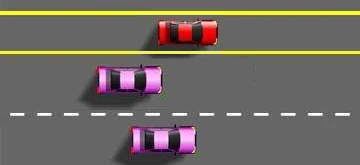 The case of R v Gray arises from an unsafe passing incident that occurred on the highway near Round Lake. A police patrol that was southbound on the highway observed 3 vehicles abreast approaching. The highway was only two lanes wide for northbound traffic so the third vehicle was passing between the widely spaced solid yellow lines marked in the centre of four lanes.
The case of R v Gray arises from an unsafe passing incident that occurred on the highway near Round Lake. A police patrol that was southbound on the highway observed 3 vehicles abreast approaching. The highway was only two lanes wide for northbound traffic so the third vehicle was passing between the widely spaced solid yellow lines marked in the centre of four lanes.

Google Map View of Area
Initial Admission by Driver
William Gray was passing by driving his vehicle between the solid yellow lines and when stopped told Constable Volz that he had simply passed the vehicle to his immediate right that was driving slowly in the outside lane.
On Second Thought, I Wasn't Passing
The constable prepared a violation ticket and during it's service Mr. Gray amended his explanation of events to include that as he approached the slower vehicle the second slower vehicle ahead of him suddenly pulled in front of him, causing him to move left to avoid a collision. He wasn't passing the other vehicles.
Defence of Necessity
Mr. Gray disputed the ticket, saying that if he would have braked instead of moving left and passing, he would have been hit by the vehicle following behind him. The judicial justice convicted him of driving without reasonable consideration for others using the highway.
Appeal of Conviction
Mr. Gray appealed the conviction before Mr. Justice Riley in the Supreme Court at Vernon. The crux of the matter was whether braking or passing was the necessary choice and the judicial justice was not convinced that braking was not a valid choice for Mr. Gray.
On review Justice Riley found:
[36] In this passage, Mr. Gray made reference to other vehicles, including at least one vehicle behind him. Later in the same passage, Mr. Gray started but did not complete his explanation of what he expected what would happen if he put on his brakes. Mr. Gray said, “I could have slammed on…”, and then stopped himself mid-sentence and went on to say he had no options but to swerve left.[37] As I read this evidence – and I stress, I am reading it from a transcript after the fact as I was not present for the testimony as the Judicial Justice was – it would appear as though Mr. Gray did not complete his thought. He did not fully explain himself as to why he believed it was not a prudent course for him apply his brakes rather than swinging into the centre lane. He simply asserted his conclusion.[38] One is left to speculate about what Mr. Gray might have said as to his ability to safely apply his brakes. One can guess what he might have said, but maybe he did not say more because he did not want to open up a can of worms or subject his full explanation to greater scrutiny.[39] In the end, it seems to me that the Judicial Justice should not have had to guess at what Mr. Gray’s explanation would have been. The burden was on Mr. Gray to lay out his due diligence defence. He had to satisfy the Judicial Justice, on a balance of probabilities, that he acted with all due diligence by addressing any objectively reasonable ways to avoid the pattern of driving that constituted the actus reus of the offence. Mr. Gray failed to convince the Justice. I cannot say that the Justice committed any reviewable error in this regard, or that the verdict was unreasonable or unsupported by the evidence.[40] The appeal is dismissed. I should add that counsel for Mr. Gray said everything that might reasonably be said on behalf of his client, but despite counsel’s able submissions, I see no basis on which to allow the appeal.
Share This Article
- Log in to post comments
